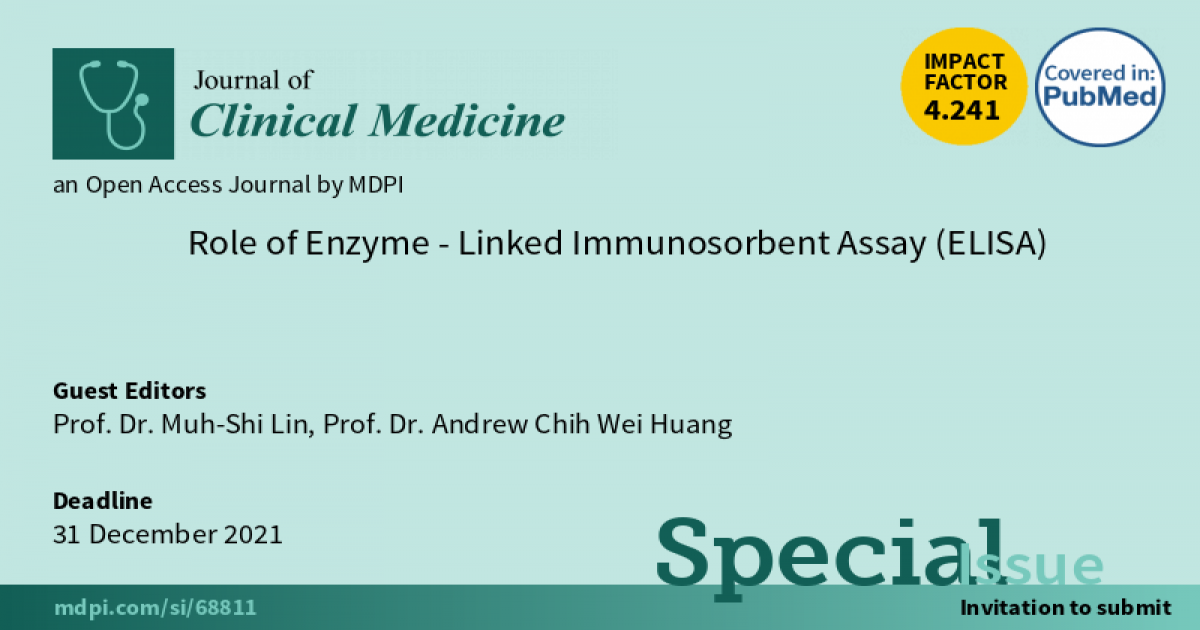Role of Enzyme-Linked Immunosorbent Assay (ELISA)
A special issue of Journal of Clinical Medicine (ISSN 2077-0383). This special issue belongs to the section "Immunology".
Deadline for manuscript submissions: closed (31 December 2021) | Viewed by 50252

Special Issue Editors
Interests: curcumin; CISD2; CAD/CAM skull reconstruction; cranioplasty; chronic subdural hematoma (CSDH)
Special Issues, Collections and Topics in MDPI journals
Interests: drug addiction; post-traumatic stress disorder; central post-stroke pain; optogenetics; chemogenetics
Special Issues, Collections and Topics in MDPI journals
Special Issue Information
Dear Colleagues,
Enzyme-linked immunosorbent assay (ELISA) can be qualitatively or quantitatively utilized to recognize analytes involving peptides, proteins, or small molecules. The ELISA technique has been linked to molecular imaging, bioinformatics analysis, Artificial Intelligence (AI)-based methods, along with therapeutic targeting with gene and cell therapy. Advances in ELISA-related applications enable early detection and precise treatment in disease management. The aim of this Special Issue is to bring leading research on multidisciplinary frontier viewpoints upon various theranostic insights in both basic and clinical issues underlying recent advances in disease and clinical management. Reviews and original articles are welcomed.
Potential topics include but are not limited to the following:
- Bench to bedside applications to the diagnosis, treatment, and clinical outcome of diseases, including ELISA-based molecular or pharmacological interventions;
- Biomarkers or risk factors involving neuroinflammation or mitochondrial function in cell to animal innovative research for disease theranostics;
- Diagnostic strategies targeting tumorigenesis, viral infections, crop/food allergens, and toxicology;
- Molecular imaging that could reflect or predict disease development;
- Biocybernetics and big data processing of large databases and genomics interactions using bioinformatics approaches.
Prof. Dr. Muh-Shi Lin
Prof. Dr. Andrew Chih Wei Huang
Guest Editors
Manuscript Submission Information
Manuscripts should be submitted online at www.mdpi.com by registering and logging in to this website. Once you are registered, click here to go to the submission form. Manuscripts can be submitted until the deadline. All submissions that pass pre-check are peer-reviewed. Accepted papers will be published continuously in the journal (as soon as accepted) and will be listed together on the special issue website. Research articles, review articles as well as short communications are invited. For planned papers, a title and short abstract (about 100 words) can be sent to the Editorial Office for announcement on this website.
Submitted manuscripts should not have been published previously, nor be under consideration for publication elsewhere (except conference proceedings papers). All manuscripts are thoroughly refereed through a single-blind peer-review process. A guide for authors and other relevant information for submission of manuscripts is available on the Instructions for Authors page. Journal of Clinical Medicine is an international peer-reviewed open access semimonthly journal published by MDPI.
Please visit the Instructions for Authors page before submitting a manuscript. The Article Processing Charge (APC) for publication in this open access journal is 2600 CHF (Swiss Francs). Submitted papers should be well formatted and use good English. Authors may use MDPI's English editing service prior to publication or during author revisions.
Keywords
- theranostic approach
- gene/cell therapy
- ELISA-based detection
- molecular imaging
- Artificial Intelligence







